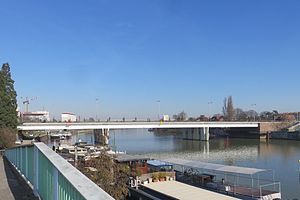Pont de Choisy
Coordinates: 48 ° 45 ′ 59 " N , 2 ° 24 ′ 44" E
| Pont de Choisy | ||
|---|---|---|
| Official name | Pont de l'Appel du 18 June 1940 - Général de Gaulle | |
| use | Road bridge | |
| Convicted | D 86 | |
| Crossing of | His | |
| place | Choisy-le-Roi | |
| construction | Prestressed concrete - box girder bridge | |
| overall length | 130 m | |
| width | 28.40 m | |
| Number of openings | three | |
| Longest span | 55 m | |
| start of building | 1962 | |
| completion | 1965 | |
| planner | Jean Muller | |
| location | ||
|
|
||
The Pont de Choisy is a road bridge over the Seine in the Greater Paris belonging Choisy-le-Roi in the department of Val-de-Marne . She was the first bridge in cantilever construction of prefabricated reinforced concrete - concrete box segments was manufactured.
Its official but rarely used name is Pont de l'Appel du 18 Juin 1940 - Général de Gaulle in memory of Charles de Gaulle's call of June 18, 1940 to the French to follow him in the fight against Germany.
location
The Pont de Choisy is part of the D86 départementale route , called avenue Jean Jaurès on the left of the Seine and avenue Victor Hugo on the other side of the river . The actual bridge structure crosses the Seine and the Quai Voltaire embankment with three fields .
In the west there is another bridge construction with which the tracks of the SNCF , the RER , line C and the avenue du 8 Mai 1945 are crossed. Right next to this building is the former station of the Chemin de Fer d'Orléans , which is used as the Maison de la Jeunesse (youth center). Access ramps and the initially elevated Avenue Victor Hugo follow to the east.
description
The bridge has one lane each for the Trans-Val-de-Marne express bus line on both sides of a central green strip , two lanes each for general traffic as well as a pedestrian and cycle path on the outer edges.
Their length between the abutments is 130 m, which is divided into three bridge fields with a length of 37.5 + 55 + 37.5 m. The deck girder is 28.40 m wide.
From a technical point of view, the Pont de Choisy designed by Jean Muller and executed by Campenon Bernard consists of two identical, parallel structures made of prestressed concrete , the carriageway slabs of which are each supported by two single-cell hollow boxes with a rectangular cross-section 2.50 m high and 3.66 m high m width and are designed as continuous beams . As with trusses , V-shaped thin disks serve as supports that are rigidly connected to the pavement beam, but due to their own elasticity can follow the changes in length of the pavement beam.
Muller used in the built 1962-1965 Pont de Choisy restarted Hohlkasten- precast segments , which in the contact process is prepared, and cantilever were fitted, the segments not with mortar , but with fast-curing epoxy resin were bonded.
In a temporary precast factory set up far from the construction site on the banks of the Seine, the individual segments were concreted with a 6.60 m wide slab and the 3.66 wide box girder in the order of their later use with their joint surfaces against each other (à joints conjugués; match casting) so that they would fit together exactly later on the bridge. After the concrete had hardened, the segments were transported to the construction site with a barge , lifted into place with a floating crane , glued and anchored to the cantilever structure with tendons.
This process had clear economic advantages over conventional production methods. The Pont de Choisy thus became the starting point for a long development in the construction of prestressed concrete cantilever bridges with prefabricated segments.
Web links
Individual evidence
- ↑ So the name tags on the roadside of the bridge, cf. Google Street View
- ↑ a b Bernard Marrey: Les Ponts Modernes; 20 e siècle. Picard éditeur, Paris 1995, ISBN 2-7084-0484-9 , pp. 191, 192
- ↑ Muller had built the small Shelton Bridge using the contact method as early as 1954, but not cantilevered it.
- ^ Daniel M. Tassin: Jean M. Muller: Bridge Engineer. In: PCI Journal , March-April 2006 (PDF; 2.1 MB)
- ^ Jean Muller: La conception des ponts. (PDF, 4.7 MB)

